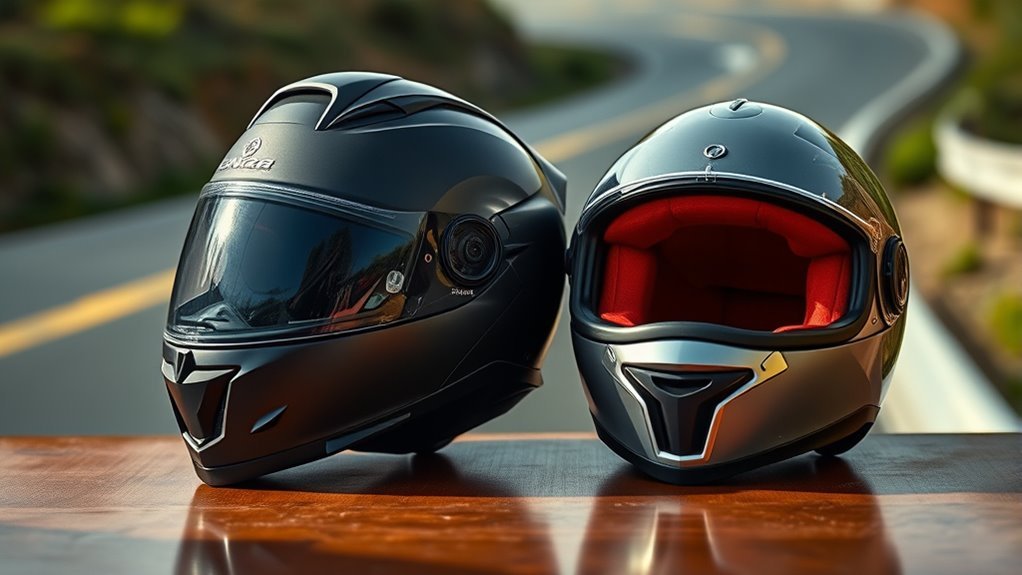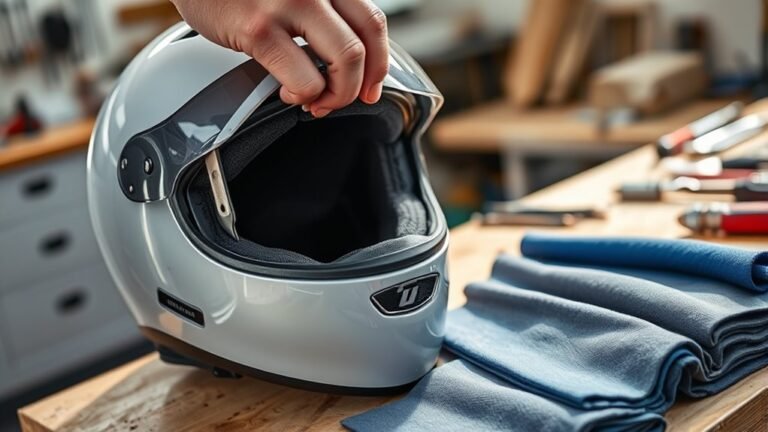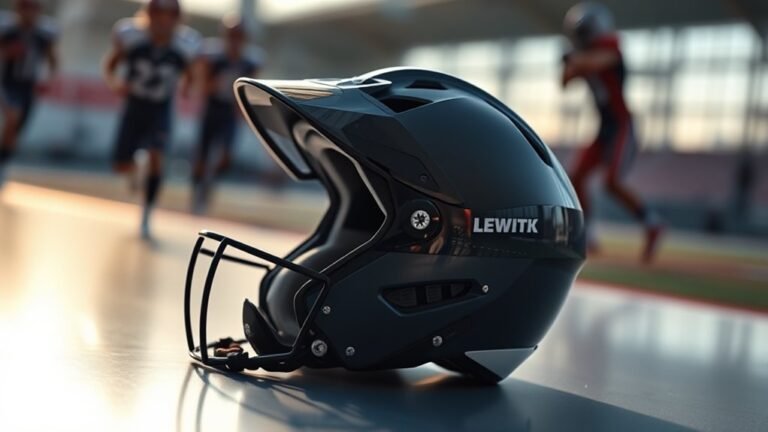Are Full-Face Helmets Safer Than Open-Face? A Comparison
Yes, full-face helmets are generally safer than open-face helmets. The design of full-face helmets offers complete coverage for your head, jaw, and face, greatly enhancing impact protection. Safety ratings typically reveal that full-face helmets meet higher standards, absorbing impacts better during crashes. While open-face helmets offer better ventilation and visibility, they expose your face to potential injuries. Understanding these differences is essential for your safety as a rider, and there’s more to take into account for making an informed choice.
Understanding Helmet Types
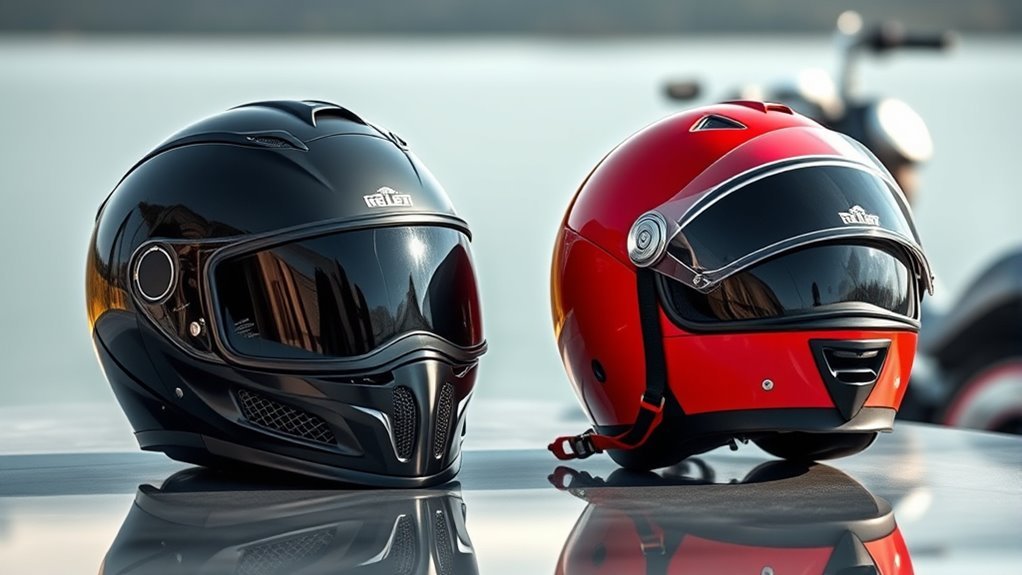
When choosing a helmet, it’s vital to understand the differences between full-face and open-face models. Full-face helmets offer complete coverage, featuring a chin bar that protects your jaw and face. This construction typically utilizes advanced materials like polycarbonate or fiberglass, ensuring durability and impact resistance. On the other hand, open-face helmets provide less coverage, allowing for greater visibility and airflow, which some riders prefer for a sense of freedom. However, their construction may use lighter materials, leading to increased comfort but potentially less protection. Understanding these material differences can help you select a helmet that aligns with your riding style and safety preferences. Whether you prioritize protection or visibility, knowing these distinctions is vital for making an informed choice.
Safety Ratings and Standards
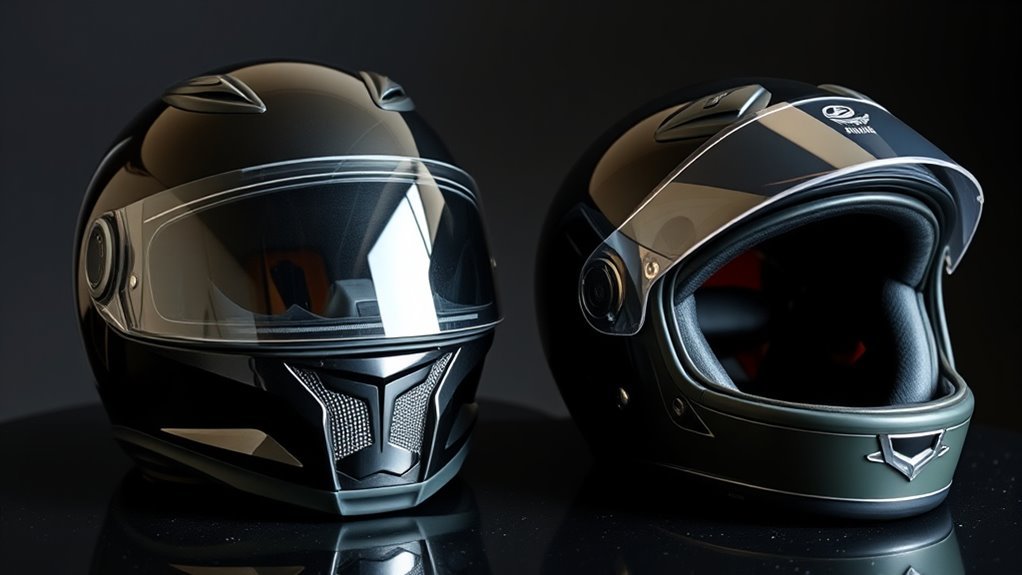
Although you may have a preference for either full-face or open-face helmets, understanding the safety ratings and standards associated with each is essential for ensuring your protection on the road. Helmets are tested against various safety standards, such as DOT, ECE, and Snell, which evaluate their performance in crash scenarios. These helmet ratings indicate how well a helmet can protect you from impacts and other hazards. Full-face helmets typically meet higher safety standards due to their design, providing more coverage. However, open-face helmets can also achieve impressive ratings, depending on their construction. Always check the safety ratings before making a purchase; knowing the standards helps you make an informed choice, ensuring you enjoy your ride while keeping safety a priority.
Impact Protection: Full-Face vs. Open-Face
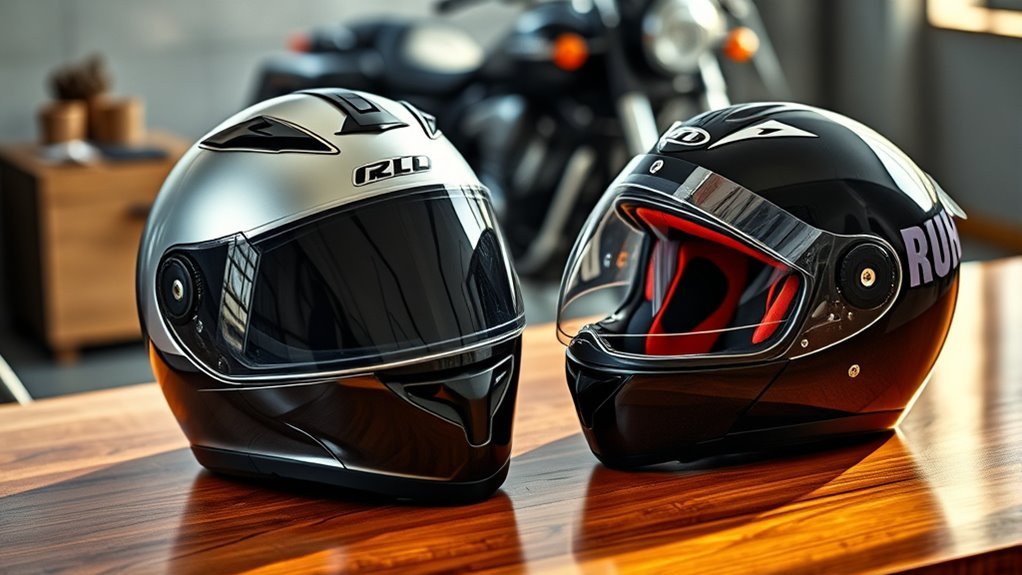
When considering impact protection, full-face helmets generally offer more coverage than open-face designs, providing a higher level of protection for the entire head, including the jaw and face. You should also evaluate the impact absorption technologies used in each type, as they can greatly affect the helmet’s ability to mitigate forces during a collision. Understanding these differences is essential for making an informed choice about your safety gear.
Coverage and Protection Levels
Many riders face an essential decision when choosing between full-face and open-face helmets, especially concerning coverage and protection levels. Full-face helmets offer significant coverage benefits, encasing your entire head and face, which can be vital in severe accidents. However, they may feel restrictive for those who crave that open-air experience. In contrast, open-face helmets provide a more liberating feel but come with serious protection drawbacks, leaving your face vulnerable to impacts.
| Helmet Type | Coverage Benefits | Protection Drawbacks |
|---|---|---|
| Full-Face | Complete head and facial coverage | May feel heavy and enclosed |
| Open-Face | Greater airflow and visibility | Exposed face and chin |
Your choice ultimately impacts your riding experience and safety.
Impact Absorption Technology
As the choice between full-face and open-face helmets can greatly affect safety, understanding impact absorption technology is essential for riders. Full-face helmets typically feature advanced materials like expanded polystyrene (EPS) and multi-density foam that absorb impact energy more effectively. These technology advancements enhance the helmet’s ability to distribute forces during a crash, reducing the risk of head injuries. On the other hand, open-face helmets often rely on simpler designs that may lack this level of protection. While they offer freedom and visibility, their impact absorption capabilities can be limited. Ultimately, choosing a helmet involves balancing desired freedom with the level of safety provided by the impact absorption technology employed in each design. Your safety should always come first.
Ventilation and Comfort
When considering ventilation and comfort, airflow efficiency is essential in determining how well a helmet manages internal temperature. Full-face helmets often limit airflow, potentially leading to heat buildup, while open-face designs typically promote better ventilation. Additionally, noise levels can vary notably between the two styles, impacting your overall riding experience.
Airflow Efficiency
Although both full-face and open-face helmets offer protection, their airflow efficiency greatly impacts rider comfort during long rides. Open-face helmets typically enhance airflow dynamics, allowing for greater ventilation and a more open experience. This design promotes cooling efficiency, helping you stay comfortable in warm conditions. In contrast, full-face helmets, while providing thorough protection, can limit airflow, often resulting in a warmer interior. However, many modern full-face designs incorporate advanced ventilation systems to improve airflow without sacrificing safety. Ultimately, your choice should consider how airflow dynamics align with your riding style and preferences. Evaluating these factors can make a significant difference in your overall riding experience, ensuring you maintain that sense of freedom while enjoying the road.
Temperature Regulation
Airflow efficiency directly influences temperature regulation within a helmet, affecting overall comfort during rides. Full-face helmets typically have less ventilation compared to open-face designs, which can lead to increased temperature effects during warm weather. If you’re sweating under a closed shell, humidity management becomes essential; inadequate airflow can create a stifling environment. Conversely, open-face helmets allow for greater air circulation, helping to dissipate heat and moisture more effectively. However, this increased airflow might compromise protection. When choosing a helmet, consider how each design meets your comfort needs in varying climates, as a well-ventilated helmet can greatly enhance your riding experience, allowing you to focus on the freedom of the ride without the distraction of discomfort.
Noise Levels
While many riders prioritize safety and comfort, noise levels inside a helmet can considerably impact your overall experience. Full-face helmets generally provide better sound insulation compared to open-face models, effectively reducing wind and road noise. This noise reduction is vital for long rides, allowing you to maintain focus and enjoy the freedom of the open road without distraction. However, the trade-off is that some full-face helmets may sacrifice ventilation, which can lead to discomfort in warmer conditions. Open-face helmets, while less effective in noise reduction, often offer superior airflow and comfort. Ultimately, your choice should balance the desire for quiet rides with the need for ventilation, ensuring you experience the ride as freely as possible.
Visibility and Peripheral Awareness
How does the design of a helmet affect your ability to see and maintain awareness of your surroundings? Full-face helmets typically offer a more restricted field of vision compared to open-face options. Their design limits peripheral awareness, which can be essential for spotting hazards while riding. You may find head movement more challenging in a full-face helmet, as the added bulk can hinder quick turns to check for oncoming traffic or other riders. Open-face helmets, on the other hand, generally provide a wider view and better peripheral awareness, allowing for easier head movement and a more natural sense of your environment. This difference in visibility and awareness can greatly impact your riding experience and safety on the road.
Weight and Balance Considerations
When considering helmet choice, weight and balance play essential roles in your overall riding comfort and safety. The weight distribution of a helmet can considerably impact how it feels on your head during long rides. Proper helmet ergonomics guarantee that the helmet sits securely without causing fatigue.
Weight and balance are crucial for helmet comfort and safety, significantly affecting long ride experiences.
- A well-balanced helmet reduces neck strain.
- Heavier helmets might cause discomfort over time.
- Ideal weight distribution enhances stability at high speeds.
- Lightweight designs can improve your sense of freedom.
Choosing the right helmet involves evaluating how these factors align with your riding style and preferences. Ultimately, a helmet that feels right can enhance your experience while prioritizing safety on the road.
Real-World Performance and Case Studies
Many riders often wonder about the real-world performance differences between full-face and open-face helmets. Analyzing real-world accidents reveals significant variations in helmet effectiveness. Full-face helmets generally provide better protection against impacts, especially to the face and jaw area, while open-face helmets offer more visibility and airflow.
Here’s a comparison of key performance metrics:
| Helmet Type | Impact Protection |
|---|---|
| Full-Face | High |
| Open-Face | Moderate |
| Helmet Type | Visibility |
| Full-Face | Moderate |
| Open-Face | High |
In these scenarios, full-face helmets often outperform their open-faced counterparts regarding overall safety during accidents, emphasizing the importance of choosing wisely for your ride.
Personal Preference and Riding Style
While safety is a primary concern for riders, personal preference and riding style greatly influence helmet choice. Your decision often comes down to how you ride and what you value in a helmet.
- Comfort: Full-face helmets can feel restrictive, while open-face options provide more ventilation.
- Visibility: Open-face helmets offer a wider field of vision, appealing to those who enjoy scenic rides.
- Aesthetics: Rider preferences vary; some prioritize sleek designs, while others may seek retro styles.
- Purpose: Different riding styles, from touring to racing, require distinct helmet features.
Ultimately, your style choices reflect your identity as a rider, blending safety with personal expression. Understanding these factors can guide you to the right helmet that matches your unique riding experience.
Frequently Asked Questions
Do Full-Face Helmets Restrict Head Movement More Than Open-Face Helmets?
Yes, full-face helmets can restrict head mobility more than open-face helmets. The design of full-face helmets often includes additional padding and a chin bar, which may limit your ability to turn your head freely. However, this can vary based on the specific helmet model. While some riders prioritize head mobility for comfort levels, others may appreciate the enhanced protection that comes with the full coverage, balancing safety and freedom of movement.
Can I Wear Glasses Comfortably With a Full-Face Helmet?
Wearing a full-face helmet with glasses can feel like trying to fit a square peg in a round hole, but it’s doable. Glasses compatibility varies by helmet design, so consider options with ample space for frames. Comfort factors like padding and fit are essential; a snug helmet shouldn’t press on your glasses, causing discomfort. Always try them on together before purchasing to guarantee you don’t compromise your visibility or comfort while riding freely.
What Is the Lifespan of a Full-Face Helmet Compared to an Open-Face?
A full-face helmet typically has a longer lifespan than an open-face helmet, primarily due to its superior helmet material durability. The construction often involves advanced composites that enhance resistance to wear and tear. Regarding impact absorption comparison, full-face helmets generally provide better protection during crashes, which can extend their functional lifespan. However, both types require regular inspections, as any damage can greatly compromise their safety regardless of material durability.
Are Full-Face Helmets Heavier Than Open-Face Helmets?
Yes, full-face helmets typically weigh more than open-face helmets due to their additional materials and construction. However, this extra weight can be balanced with effective weight distribution, enhancing comfort levels during rides. While some riders may find the extra weight cumbersome, others appreciate the added protection. Ultimately, it’s about personal preference and how you prioritize safety versus comfort while enjoying the freedom of the open road.
How Do Weather Conditions Affect Helmet Choice?
Weather conditions greatly impact your helmet choice, especially regarding weather protection and temperature regulation. In cold or wet conditions, a full-face helmet offers better coverage, keeping you warmer and shielded from rain. However, in hot weather, an open-face helmet might provide better airflow, preventing overheating. You’ll need to balance protection with comfort, ensuring you stay safe while enjoying your ride, regardless of the elements. Choosing the right helmet can enhance your overall experience.
